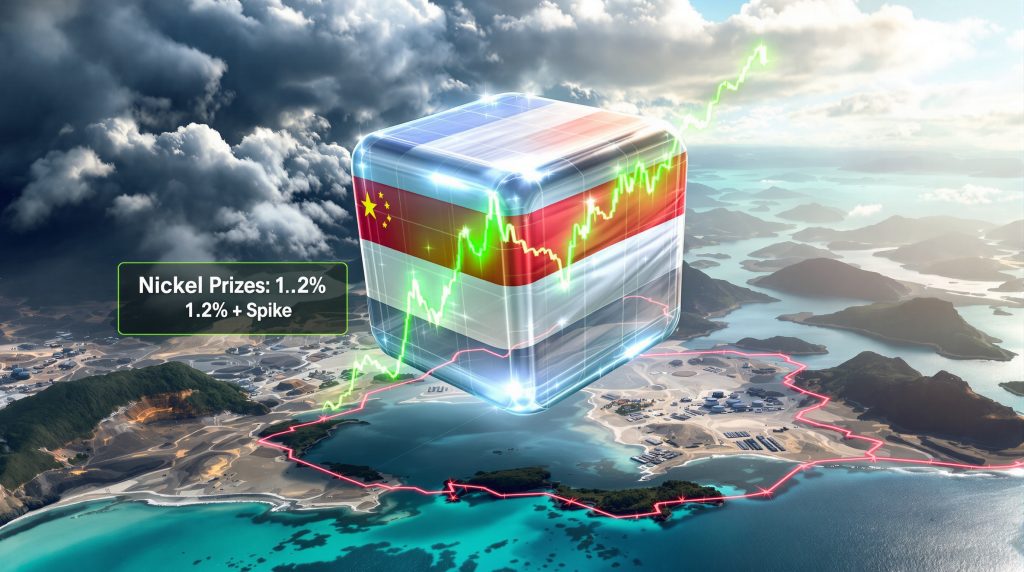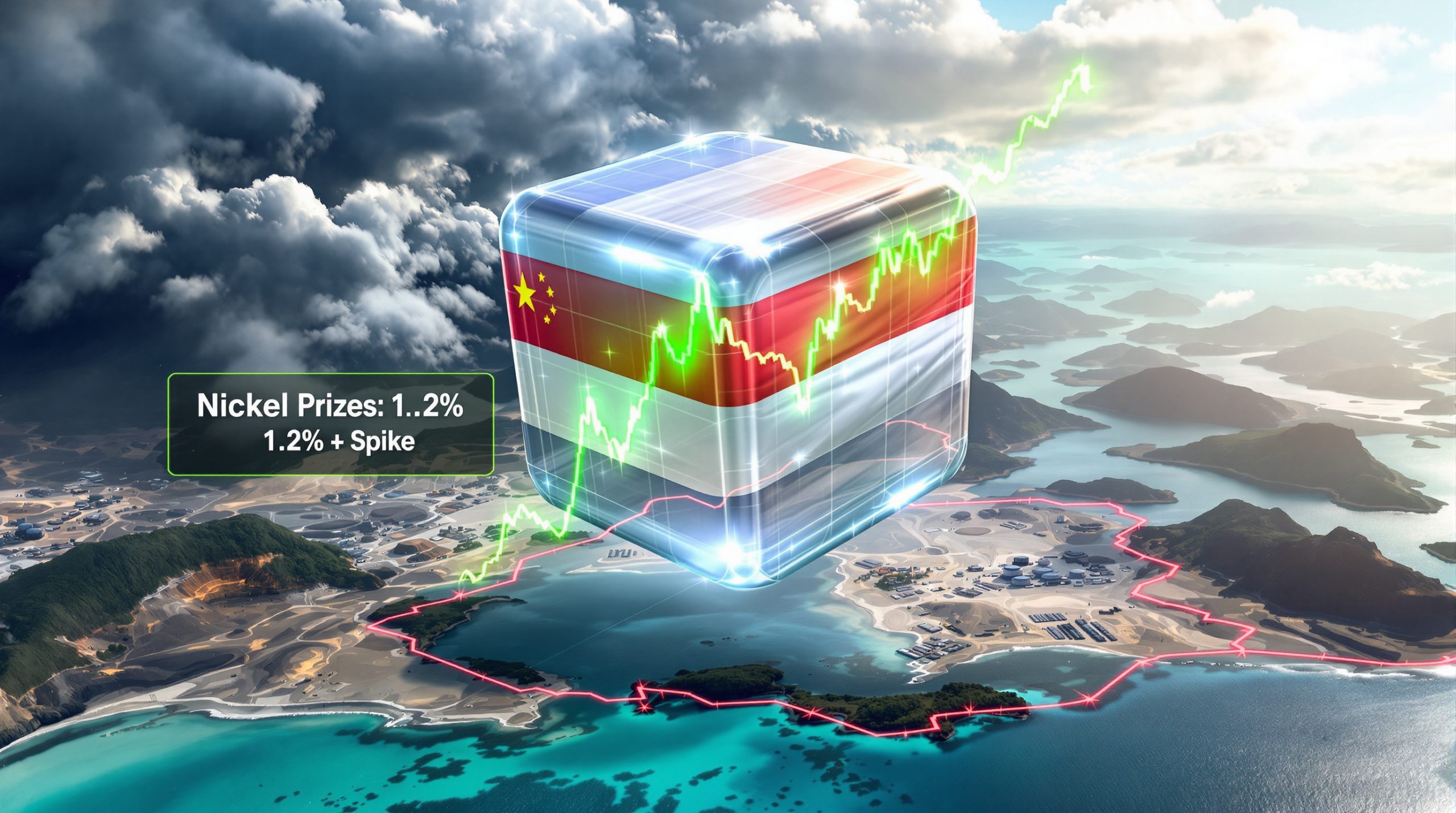Why Are Nickel Prices Suddenly Rising?
The recent government seizure of a portion of the world's largest nickel mine has sent ripples through global commodity markets, pushing nickel prices upward by 1.2% on the London Metal Exchange. This regulatory intervention underscores the fragility of global nickel supply chains and highlights Indonesia's growing assertiveness in managing its critical minerals demand surge.
The Regulatory Intervention That Shocked Markets
On September 12, 2025, Indonesian authorities seized approximately 148 hectares of the PT Weda Bay Nickel operation, citing alleged permit violations as justification. The move immediately triggered price reactions across metal markets, with nickel futures climbing to $15,335 per ton on the LME during Singapore trading hours.
The seizure broke months of range-bound trading at relatively low price levels, signaling to investors that supply risk remains a significant factor in the nickel market despite recent demand weakness.
Other base metals followed suit in sympathy trading, with copper advancing 0.6% and aluminum rising 0.5%, reflecting broader concerns about global tariff impacts and regulatory risk in key mining jurisdictions.
Understanding Weda Bay's Strategic Importance
PT Weda Bay Nickel represents one of the world's most significant nickel production centers, operating as a joint venture with international stakeholders. China's Tsingshan Holding Group, the country's top nickel producer, holds a major stake in the operation alongside France's Eramet SA.
The mine's scale and production capacity make it a cornerstone of global nickel supply, particularly for stainless steel manufacturing and increasingly for electric vehicle battery production. Its strategic importance extends beyond mere tonnage—the operation serves as a flagship project in Indonesia's critical minerals mission.
Situated in a mineral-rich region with favorable geology, Weda Bay benefits from ore grades and mining conditions that make it one of the most cost-effective nickel operations globally, further enhancing its importance to market stability.
How Vulnerable Is the Global Nickel Supply Chain?
The seizure at Weda Bay highlights structural vulnerabilities in the global nickel market that have been building for years, particularly the increasing concentration of production in a single country with an evolving regulatory approach.
Indonesia's Dominant Position in Global Nickel
Indonesia currently controls well over 50% of worldwide nickel production, having rapidly expanded its mining and processing capacity over the past decade. This dominance gives Indonesian policy decisions outsized impact on global supply and pricing.
The country's rise to prominence began with its vast laterite nickel deposits but accelerated dramatically after policy changes in 2014 that banned the export of unprocessed ore. This export restriction forced mining companies to invest in domestic processing facilities, transforming Indonesia from primarily an ore exporter into a major producer of refined nickel products.
Its position as the primary supplier to Chinese processing facilities creates a critical link in the supply chain for both stainless steel and battery manufacturing industries. Any disruption to Indonesian production—whether from regulatory actions, weather events, or logistical challenges—can quickly reverberate through global markets.
Existing Supply Challenges in 2025
Even before the Weda Bay seizure, Indonesia's nickel sector had been facing significant operational constraints throughout 2025. Unusually high rainfall has hampered mining operations across Indonesian nickel regions, creating difficulties in maintaining consistent ore extraction rates.
Simultaneously, the government has been slow to issue new mining quotas, creating artificial limits on authorized production levels. This hesitation in quota allocation has been interpreted by some market participants as a deliberate strategy to maintain price support rather than a purely administrative delay.
These combined factors created a tight ore market for smelters operating in Indonesia, with many facilities unable to secure sufficient feedstock to maintain optimal utilization rates. Logistics challenges have further complicated the situation, with transportation bottlenecks affecting the movement of ore from mines to processing facilities.
What Is President Prabowo's Resource Strategy?
President Prabowo Subianto's administration has signaled a shift in how Indonesia manages its natural resources, with implications extending beyond the nickel sector to the broader mining industry.
Indonesia's Evolving Mineral Policy Framework
Since taking office, President Prabowo has outlined ambitious national development plans requiring significant funding, much of which is expected to come from the country's vast natural resource wealth. His administration has emphasized maximizing returns from these resources while ensuring compliance with regulatory frameworks.
The president has promised a crackdown on illegal mining operations, which have long operated in gray areas of Indonesia's regulatory environment. This enforcement push aims to bring all mining activity under proper government oversight and ensure the state captures appropriate economic benefits.
Environmental compliance has received increased regulatory attention, with stricter enforcement of existing rules rather than wholesale policy changes. This reflects a growing awareness of the ecological impacts of rapid mining expansion, particularly in sensitive island ecosystems.
The administration continues to pursue a delicate balance between attracting foreign investment and promoting domestic economic interests. While international capital and expertise remain welcome, they must increasingly operate within frameworks that prioritize Indonesian participation and downstream value addition.
Regulatory Enforcement Patterns Emerging
The Weda Bay seizure appears to be part of a systematic review of mining operations rather than an isolated incident. Government officials have indicated that similar inspections are underway at other mining sites across the country.
The targeted action against a high-profile operation like Weda Bay sends a clear signal to the broader mining sector about the government's seriousness in enforcing permit compliance. By choosing a site with international ownership, authorities demonstrated that even well-connected operations are not exempt from scrutiny.
Observers note that the focus appears to be on permit compliance and proper authorization rather than a fundamental shift in resource nationalism. This suggests that operations with proper documentation and regulatory adherence may face less risk of similar interventions.
The pattern indicates a preference for corrective measures rather than permanent shutdowns, with the government likely seeking to bring operations into compliance rather than halting production entirely.
How Are Key Stakeholders Responding?
Different parties involved in the Weda Bay operation have offered varying assessments of the situation's severity and potential impacts on their interests and the broader market.
Mining Company Reactions and Mitigation Strategies
France's Eramet SA, a major shareholder in the Weda Bay operation, has publicly stated it sees no immediate impact on current operations, suggesting the seized area may not be critical to ongoing production. This measured response has helped prevent more dramatic market reactions.
Tsingshan Holding Group has maintained a lower public profile regarding the seizure, with limited official commentary on the situation. This approach is consistent with the company's typically reserved communications strategy regarding regulatory challenges.
Other nickel producers operating in Indonesia have reportedly accelerated compliance reviews of their own operations to ensure all permits and authorizations are in proper order. This proactive approach aims to prevent similar regulatory interventions at their sites.
Industry sources indicate that contingency planning has intensified across the sector, with companies developing response strategies for potential regulatory actions. These plans typically include legal remedies, stakeholder engagement approaches, and operational continuity measures.
Market Participant Perspectives
Metal traders have incorporated a modest risk premium into nickel contracts following the seizure, reflecting increased uncertainty about supply stability. However, this premium remains relatively small compared to historical volatility episodes, suggesting limited expectations of major disruption.
Investment analysts have noted that the market impact has been tempered by currently weak demand conditions, particularly from the electric vehicle sector. This demand softness provides a buffer against supply disruptions that might otherwise cause more significant price reactions.
Commodity strategists point out that the seizure affects only a portion of the overall Weda Bay complex, limiting its immediate production impact. This partial nature of the intervention has contributed to the measured market response.
Long-term investors in Indonesian mining assets are reassessing regulatory risk profiles but have not initiated major position changes. The consensus view appears to be that compliance-focused operations with strong government relationships remain viable investment targets despite elevated regulatory scrutiny.
What Does This Mean for Battery Metal Supply Chains?
Nickel is a critical component in high-performance EV batteries, making supply stability a matter of strategic importance for automakers worldwide and battery manufacturers.
Electric Vehicle Industry Vulnerability
Battery manufacturers require reliable access to high-quality nickel inputs, particularly Class 1 nickel suitable for battery applications. The concentration of supply in Indonesia creates potential single-point-of-failure risks in these critical supply chains.
The timing of the regulatory intervention comes during a period of transformation for battery manufacturers, many of whom are balancing between high-nickel chemistries for maximum energy density and alternative formulations that reduce dependency on constrained materials.
Supply chain planners at major automakers have been working to diversify nickel sourcing for several years, but Indonesia's dominant production position makes complete diversification challenging. Even modest disruptions can impact material availability and pricing for battery production.
Price volatility complicates long-term procurement strategies, particularly for automakers with fixed-price vehicle offerings. The ability to hedge nickel exposure becomes increasingly important in an environment of regulatory uncertainty.
Alternative Supply Sources and Substitution Possibilities
The disruption has accelerated interest in nickel projects outside Indonesia, with development activities in Australia, Canada, and the Philippines receiving renewed attention. However, bringing significant new capacity online requires substantial lead time, limiting near-term diversification options.
Battery chemistry researchers have intensified work on formulations that require less nickel content, including lithium iron phosphate (LFP) batteries for applications where energy density requirements are less stringent.
Recycling capacity development has gained momentum as a strategic priority, with several major facilities under construction to recover nickel and other battery materials from end-of-life products. However, meaningful volumes from recycling remain several years away.
Some manufacturers have begun strategic stockpiling of critical materials including nickel to buffer against supply disruptions. This approach provides short-term security but requires significant capital allocation and storage capacity.
How Will This Affect Nickel Prices Through 2025?
The seizure at Weda Bay represents just one factor in a complex market that has been characterized by significant supply-demand imbalances and price volatility in recent years.
Short-Term Market Dynamics
Nickel prices have been trading in a relatively narrow range for months prior to the seizure, with the metal struggling to gain momentum despite supply concerns. The immediate 1.2% price jump following the regulatory action broke this pattern but remains modest compared to historical volatility episodes.
Demand disappointment from the EV sector has kept downward pressure on prices throughout much of 2025, offsetting potential supply-driven price support. Battery manufacturers have been cautious in raw material procurement amid uncertain production forecasts.
Inventory levels at exchanges have fluctuated but remained generally adequate to buffer short-term supply disruptions. This inventory cushion helps explain the measured price response to the Weda Bay situation.
Trading patterns following the seizure announcement showed heightened activity during Asian market hours, with participants reassessing risk exposures and adjusting positions to account for increased uncertainty.
Longer-Term Price Outlook Factors
Regulatory risks will likely feature more prominently in market assessments going forward, with a risk premium potentially becoming a more permanent feature of nickel pricing. This could establish a higher floor for prices even amid demand weakness.
Weather-related disruptions could compound supply challenges during Indonesia's upcoming rainy season, which typically runs from November through March. The combination of regulatory uncertainty and seasonal production challenges may create periods of more acute supply tightness.
Demand recovery remains uncertain given global economic conditions and the uneven pace of EV adoption across markets. A significant demand catalyst would be required to drive prices substantially higher from current levels.
The fundamental tension between Indonesia's growing production capacity and softer-than-expected demand growth will continue to dominate longer-term price trends, with regulatory interventions adding volatility rather than changing the underlying balance.
What Are the Broader Implications for Mining Investment?
The Weda Bay seizure raises important questions about investment risk in resource-rich nations and how mining companies should approach jurisdictions with evolving regulatory frameworks.
Resource Nationalism Trends Globally
Indonesia's approach to resource management fits within a broader global pattern of producer nations seeking greater control and economic benefits from their natural resources. Similar trends have emerged in lithium-producing nations like Chile and cobalt-rich Democratic Republic of Congo.
The focused enforcement on permit compliance represents a more sophisticated approach to resource control than blunt instruments like nationalization or arbitrary tax increases. This compliance-oriented approach maintains investment attractiveness while increasing government leverage.
Mining investment risk premiums have gradually increased across multiple jurisdictions as resource nationalism becomes more prevalent. This trend affects capital allocation decisions and required returns for projects in countries perceived to have elevated regulatory risk.
International mining companies increasingly recognize that robust government relations and impeccable regulatory compliance are as crucial to project success as technical and financial factors. This recognition has driven changes in corporate structure, with government affairs functions gaining prominence.
Strategic Minerals Security Considerations
Governments in consuming nations have responded to supply concentration risks by developing critical minerals strategies that emphasize diversification and security of supply. These initiatives include financial support for domestic production, strategic stockpiles, and international agreements.
Corporate strategies increasingly incorporate geographical diversification as a core principle, with companies willing to accept higher production costs in exchange for reduced concentration risk. This shift benefits mining jurisdictions with stable regulatory environments despite potentially higher operating costs.
Public-private partnerships have emerged as a model for developing strategic mineral projects, with government support helping to mitigate investment risks. These arrangements reflect the growing recognition of critical minerals as strategic rather than purely commercial resources.
International coordination on mineral security has intensified, with consuming nations forming alliances to promote supply diversification and resilience. These efforts aim to reduce vulnerability to disruptions in any single producing region.
FAQ: Indonesia's Nickel Industry and Global Markets
What percentage of global nickel does Indonesia produce?
Indonesia currently accounts for well over 50% of global nickel production, having dramatically expanded its output over the past decade. This market share has grown from approximately 28% in 2015 to its current dominant position.
The country hosts approximately 22% of global nickel reserves but has developed these resources more aggressively than other nations with significant deposits. Indonesia's favorable geology and supportive policy environment have enabled this rapid production expansion.
Production is primarily concentrated in two regions: Sulawesi and Halmahera (where Weda Bay is located). These areas have seen intensive development of both mining operations and processing facilities.
Indonesian output includes various nickel products, from ore and nickel pig iron to more refined products like ferronickel and increasingly, battery-grade materials. The government's push for downstream processing has accelerated this product diversification.
How does nickel mining affect Indonesia's environment?
Nickel mining in Indonesia has been associated with significant environmental challenges, including deforestation in mining areas, soil erosion from open-pit operations, and water quality impacts in coastal regions near processing facilities.
Carbon emissions from processing facilities, particularly those using coal-fired power, have raised concerns about the climate impact of Indonesia's nickel industry. This has implications for the environmental credentials of end products like electric vehicles.
Tailings management presents ongoing challenges, particularly in regions with high rainfall that can increase the risk of containment failures. Improved practices have been implemented at newer operations, but legacy issues persist at some sites.
Community impacts include displacement, changes to traditional livelihoods, and social disruption in areas experiencing rapid industrial development. Companies with more robust environmental and social governance practices typically manage these impacts more effectively.
What alternatives exist to Indonesian nickel?
Alternative sources include mines in the Philippines, which has similar laterite deposits but less developed processing infrastructure. Philippine production could increase in response to Indonesian supply concerns, though regulatory challenges exist there as well.
Australia offers significant nickel production potential from both existing operations and new projects under development. Australian nickel tends to be sulfide rather than laterite ore, often yielding higher-grade products with different processing requirements.
Canada and Russia host substantial nickel resources, primarily sulfide deposits that produce high-quality nickel suitable for battery applications. Political considerations affect the attractiveness of Russian material for many Western consumers.
Recycling of nickel from batteries and other sources is emerging as a supplementary supply channel, though volumes remain limited relative to primary production. Several major recycling facilities are under development globally, with significant capacity expected online by 2027-2028.
How important is nickel to EV battery production?
Nickel is a critical component in high-performance lithium-ion batteries, particularly in nickel-manganese-cobalt (NMC) and nickel-cobalt-aluminum (NCA) chemistries that dominate the premium EV segment. These formulations typically contain 60-90% nickel in their cathode materials.
Higher nickel content generally enables greater energy density, translating to longer driving range—a key consumer priority for EV adoption. This relationship has driven battery manufacturers toward increasingly nickel's properties and uses in recent years.
Class 1 nickel (>99.8% purity) is required for battery applications, representing a subset of total nickel production. The processing requirements for battery-grade material are more stringent than for traditional stainless steel applications.
Alternative battery chemistries like lithium iron phosphate (LFP) require no nickel and have gained market share in certain applications, particularly where cost is prioritized over maximum energy density. This shift has moderated nickel demand growth from the EV sector.
Navigating Uncertainty in Critical Mineral Markets
The seizure of part of the Weda Bay nickel operation represents another chapter in the evolving relationship between resource-rich nations and the global markets that depend on their minerals. For investing guide 2025, manufacturers, and policymakers, several key considerations emerge from this situation.
First, regulatory compliance has become as critical as operational excellence in determining mining project success. Companies must maintain impeccable documentation and relationships with host governments to minimize disruption risk.
Second, supply diversification remains an essential strategy despite its challenges. While Indonesia's dominance cannot be quickly overcome, gradual development of alternative sources provides crucial resilience against both regulatory and operational disruptions.
Third, technology adaptation offers a partial solution to supply constraints. Battery chemistries that reduce dependency on constrained materials provide flexibility, though performance trade-offs must be carefully managed.
Finally, transparent engagement between governments and industry stakeholders can reduce uncertainty and promote stable investment environments. Clear regulatory frameworks, consistently applied, benefit both producing nations and global markets.
As the global transition to clean energy accelerates, the strategic importance of battery metals like nickel will only increase. Navigating the complex interplay of geology, politics, economics, and technology will remain essential for all participants in these critical supply chains.
Ready to Spot the Next Major Mineral Discovery?
Discover how major ASX mineral discoveries can lead to significant market returns by exploring Discovery Alert's dedicated discoveries page, where the proprietary Discovery IQ model helps investors identify high-potential opportunities before the broader market recognises them.




